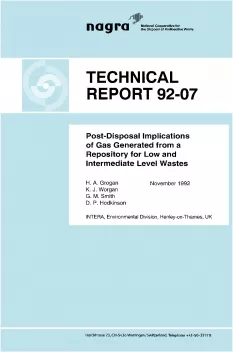
Technical Report NTB 92-07
Post-Disposal Implications of Gas Generated from a Repository for Low and Intermediate Level Wastes
The generation of gases within a deep geological repository for radioactive wastes may have significant post-emplacement implications for repository safety. This report examines this issue in the context of short-lived low- and intermediate-level waste (L/ILW) disposal in Switzerland, according to the Nagra SMA repository development programme.
The various gases which may be generated are briefly reviewed along with their sources and estimated generation rates. Hydrogen and methane are recognised as the two main gases requiring closer evaluation. Hydrogen is generated primarily during the anaerobic corrosion of metals whereas methane and CO2 are produced mainly during the chemical and microbiological degradation of organic materials under anaerobic conditions.
The report goes on to identify and investigate three potentially important scenarios related to gas production within a Swiss L/ILW repository. These are:
- radiological consequences arising from 14C and tritium becoming incorporated in methane and hydrogen gas and rapid transfer of this gas to the biosphere,
- flammable or explosive hazards associated with hydrogen and methane gas entering a confined space in the biosphere,
- gas pressure effects, causing expulsion of water from the repository environment and even physical disruption of the cavern lining.
The potential significance of these scenarios has been quantified primarily by way of scoping and bounding calculations for two operational waste streams, BA-1a and BA-5 (Nagra 1984). BA-1a consists of ion exchange resins which contain significant amounts of degradable organic materials, and BA-5 consists of steel and other metallic waste immobilised in a cement matrix, a major potential source of hydrogen. Subsets of these streams and other wastes have also been considered where these contain particularly high levels of relevant radionuclides.
The radiological consequences arising from 14C and tritium substituted methane and hydrogen gas generated from ion exchange resins are extremely small. Using conservative assumptions the maximum annual doses associated with average BA-1a waste are predicted to be of the order of 10-11 Sv a-1 per metre of repository tunnel and to be dominated by 14CH4. Even allowing for the fact that a small proportion of the wastes may have a higher 14C and organic material content, then the total dose is thought extremely unlikely to exceed about 10-8 Sv a-1.
The hydrogen gas production rates do not represent a flammable or explosive hazard on the surface. However, if a single rapid flow path to the surface were connected to the total length of tunnel containing all the BA-5 then the potential source term could be sufficient for the lower explosive limit to be reached in a confined space in a building connected with the flow path. In terms of Swiss performance assessment requirements, such a combination of factors is deemed to be a scenario which cannot be realistically assumed.
Of the scoping and bounding calculations carried out, the major gas scenario of potential significance concerns the effect of the gas pressure on groundwater movement within the repository environment and its structural integrity. Assuming the repository is fully resaturated at repository closure the scoping calculations indicate that initially all the generated gas goes into solution. The repository porewater becomes fully saturated with hydrogen within a few years at which time a free gas phase forms. For waste stream BA-5 this is 25 days if the gas arising from aluminium and zinc corrosion is included, otherwise the time is longer (2.5 years). Assuming that there are no cracks in the liner the scoping calculations indicate that the excess gas pressure would rise rapidly and sufficiently to overcome the capillary pressures in the liner. At this point the gas would enter and move through the liner and/or initiate cracks in the repository liner, allowing the gas to escape through the cracks produced.
These calculations are based on conservative assumptions. In reality gas generation rates can be expected to be at least one order of magnitude smaller. The contribution of aluminium and zinc to the gas volumes generated is probably overestimated recognising that much of the corrosion and hence gas generation is likely to occur prior to emplacement in the repository. The scoping calculations focus on those waste streams expected to generate the greatest quantities of gas and it is assumed that it all is placed together within the repository. The particular distribution of these wastes among others within the caverns would clearly affect the significance of gas generation.
It is unlikely that the repository liner would be of such a uniformly low permeability. The occurrence of small cracks as a result of thermal stresses during curing is inevitable. Such cracks will have lower capillary pressures. For this reason it is considered unlikely that the generated gas pressure effects would result in a loss of structural integrity but rather the expulsion of near field groundwater.
